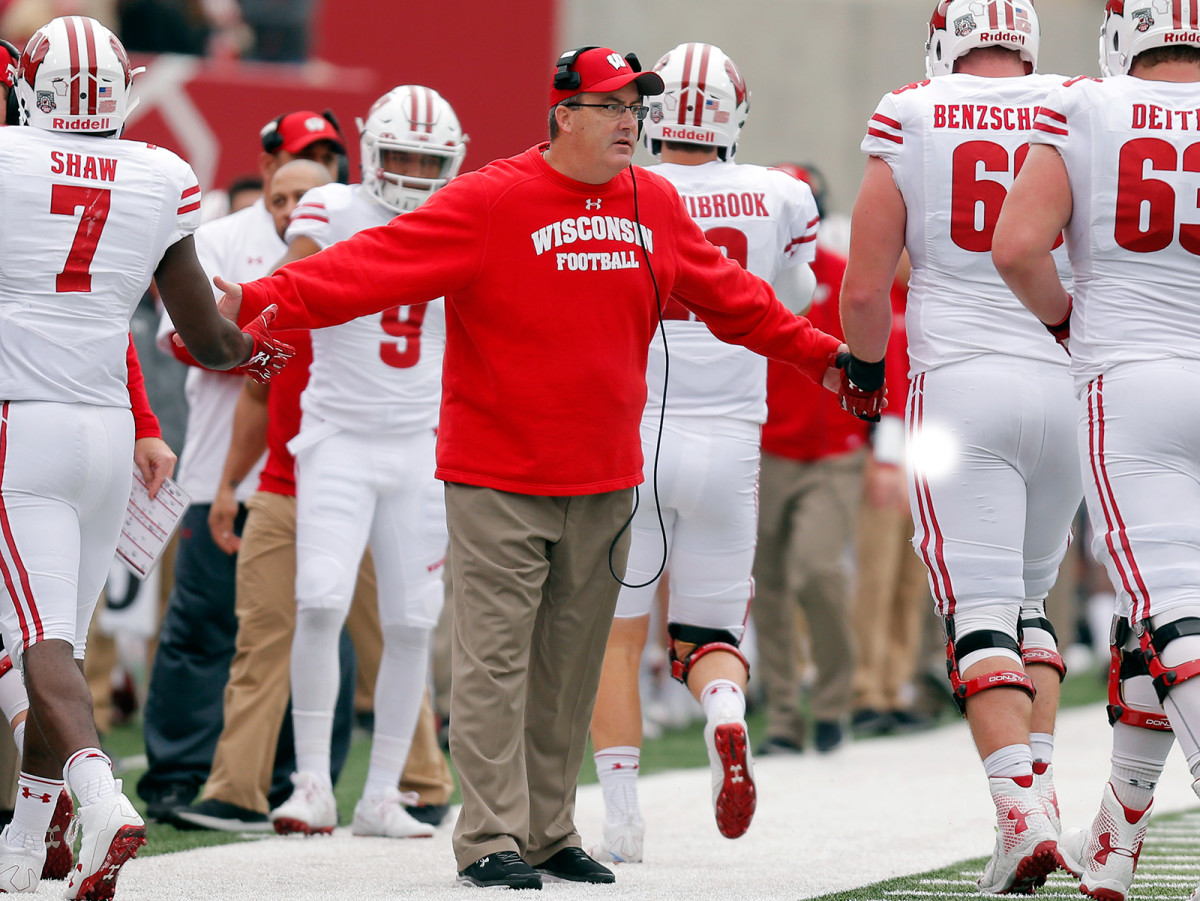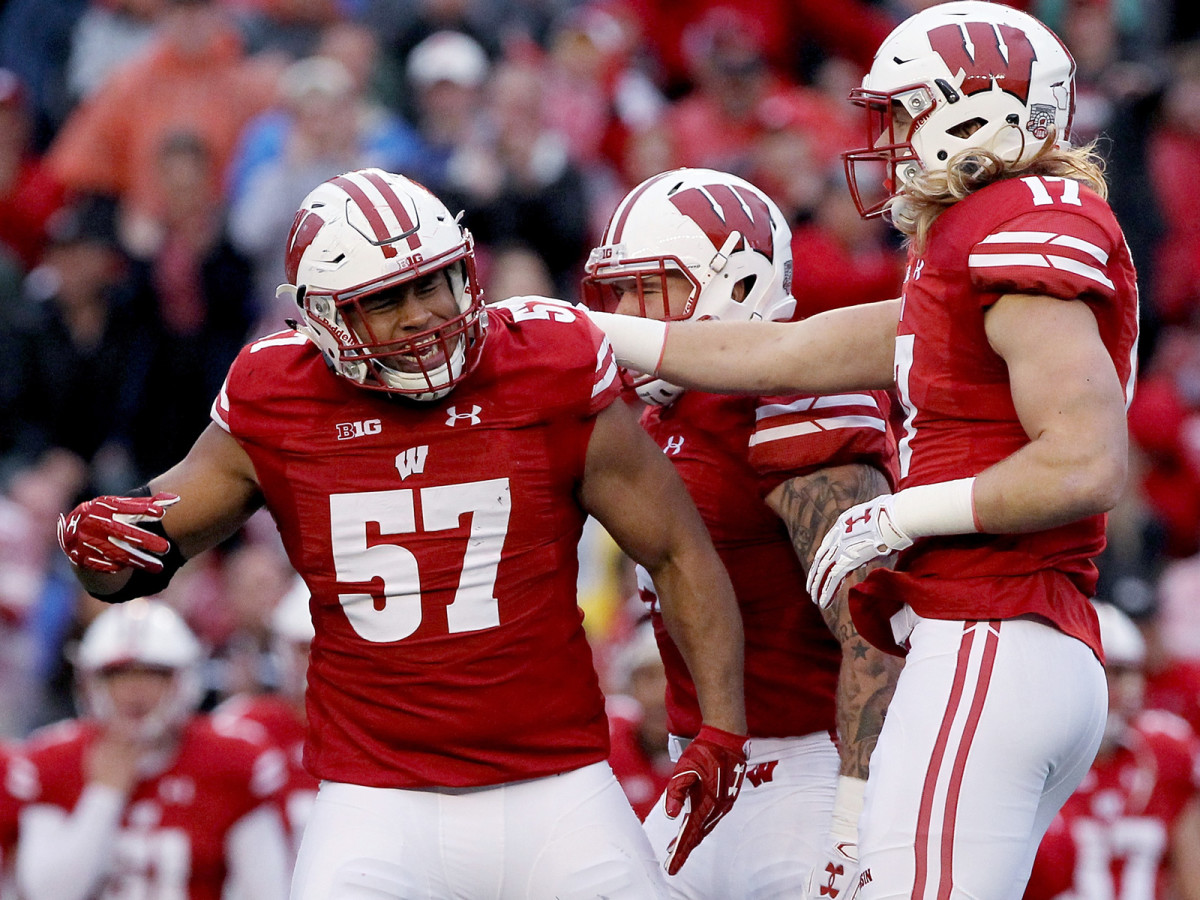The Wall Around Wisconsin: How the Badgers Looked Inward to Build a Perennial Power

The airport was empty.
Chris Haering dropped his rental car keys at an unmanned counter, breezed through a security checkpoint staffed by a single TSA agent and searched in vain for an open food vendor. He was the only one at his gate as a solo airline employee announced his evening flight from Duluth, Minn., to Madison, Wis. About 10 minutes before takeoff, two other passengers sauntered onto the plane, his only companions. They knew better than he about the need to board early for a flight from the northern tip of the country in the dead of winter.
When he joined Wisconsin’s staff in 2015, Haering was a Pennsylvania man through and through. After 17 years coaching high school ball in Pittsburgh, he caught on with Paul Chryst’s staff at Pitt in 2012 and made the move to Madison when Chryst took over the Badgers after the 2014 season. In addition to his role as special teams coordinator, Haering became the lead in-state recruiter—which is how, on his first trip to this part of Wisconsin, he’d found himself driving north from Madison to Eau Claire, then north another two hours to Superior, tucked between the lake bearing its name and Duluth, across the Minnesota border. “This was in mid-January, so it was iced-in,” Haering recalls. “A coach up there said you bring blankets and sweatshirts to a youth baseball game in July, because you just never know what’s going to blow in off the lake. I’m going, Wow, this is a little bit different.”
It didn’t take long for Haering to recognize the importance of trips to the state’s farthest reaches. Milwaukee, Wisconsin’s biggest metro area, has a population of 1.5 million; Madison, the next-biggest city, sits at 252,551. The state’s other 3.7 million residents live in towns beyond the interstate and on farms along the country roads—hamlets which yield the talent that fuels one of the most consistently successful programs in the nation.
Since 2014, only three schools have won more games than Wisconsin: Alabama, Ohio State and Clemson. After defeating Indiana 45–17 last Saturday, the Badgers are 9–0, ranked No. 8 and have all but clinched the Big Ten’s West Division. Although they are led by freshman running back Jonathan Taylor, a Heisman candidate from Salem, N.J., and sophomore quarterback Alex Hornibrook (West Chester, Pa.), exactly half of their players grew up in-state.
That strong in-state presence dates back to 1990, when legendary coach Barry Alvarez took charge of the program. He resolved to “build a wall around this state,” and in the process created a culture that remains today in Madison, where he still serves as the Badgers’ athletic director. Successive coaches—especially Alvarez’s successor, Brett Bielema, and Chryst—have kept that barrier intact, building loyalty, cultivating walk-ons, piling up victories and indoctrinating two generations of natives in the Wisconsin Way.

Haering is an outlier on a staff chock full of Badgers. Chryst is the son of a revered coach at D-III Wisconsin-Platteville. He went to high school in Platteville and was the Badgers’ backup quarterback from 1986 through ’88. Defensive coordinator Jim Leonhard is a native of Tony (pop. 113) who played safety under Alvarez from 2001 through ’05. And offensive coordinator Joe Rudolph, while not a Wisconsin native, was a Badgers O-lineman from 1992 through ’94. No other school that’s been ranked in the Top 25 this season has a trio of alumni as its coach and coordinators.
Rudolph started on the ’93 Badgers’ team that won its first Big Ten title in three decades in Alvarez’s third season. The coach had arrived after two seasons as Notre Dame’s defensive coordinator to find a state full of recruits wearing Michigan and Michigan State T-shirts. He told them he was the guy to turn the program around, and many began to believe. Most importantly, Alvarez mined the football talent in the state’s small towns, which was critical given Wisconsin’s geography: Of the states north of the Mason-Dixon Line, only 10 are more rural, and of those just one (Iowa) has a Power Five football program. On this year’s Wisconsin team, 47 players on the roster hail from outside of Milwaukee and Madison, in towns whose populations range from 105,000 (Green Bay) to 375 (Amherst Junction).
“You go down to Florida, and you stop, and you get 15 D-I kids [at one school],” says Leonhard, who played a decade in the NFL. “When you [recruit Wisconsin players], you might have to go 300 miles between them. It’s just kind of a [lack of] bang for your buck, as far as recruiting goes. Most people are not going to go out of their way to recruit the area.”
The Badgers’ success with walk-ons gives recruiters even greater clout: Since 1990, 19 from Wisconsin have reached the NFL. Often, these players didn’t play high-level high school football, but UW coaches spotted their talents at track meets and basketball games. “Sometimes when you turn on the high school tape, you see kids that maybe aren’t as developed in football skills yet,” Haering says. “You have to maybe see through some of those layers and project a little bit.”
Haering says the program’s commitment to walk-ons necessitates two recruiting cycles: one in which he and the rest of the staff pitch kids with multiple offers, then another, later, when they push for less developed talent. Coaches aren’t neglecting coveted players—of the 16 four- and five-star recruits raised in Wisconsin over the last decade, 13 enrolled at Madison—but it’s no surprise then that under-recruited players in the state are willing to forgo better opportunities at lesser football programs for a shot at the Badgers. When senior inside linebacker Jack Cichy of Somerset (pop. 2,635) was deciding between taking an Ivy League offer or walking on at Madison in 2013, he needed only to look at the team’s starting quarterback, Joel Stave of Greenfield (pop. 36,720), and leading receiver, Jared Abbrederis of Wautoma (pop. 2,218), neither of whom started out with a scholarship.
While schools like Texas and Florida snap up five-star in-state recruits at the top of their game, Wisconsin stocks its roster with players who seem to come out of nowhere. Consider J.J. Watt, a second-team All-America at Wisconsin in 2010 and three-time NFL Defensive Player of the Year, who walked on as a transfer in 2008. Or Ryan Ramczyk, the offensive tackle who was a first-round draft pick in 2017, four years after he’d been enrolled in technical school and pondered a career as a welder. Nowhere might be an understatement.
At Madison, walk-ons receive the same gear, the same sized lockers and the same opportunities—players rarely know who’s playing for a scholarship and who’s a four- or five-star guy. All have a respect for Wisconsin’s traditions. When players began complaining about the rigors of camp one recent summer, strength coach Ross Kolodziej handed out one of his training camp schedules from the 1990s under Alvarez, when practices were run three times a day. That quieted his players. “One thing we benefit from is not having a bunch of five-star guys that think they’re going to go straight to the league,” Kolodziej says. “You have guys who were under-recruited and have a chip on their shoulder.”

The road to Madison—really, any road to Madison—runs through dairyland, green in the summer, blanketed with snow in the winter. Traffic is sparse, and the tallest structures are crop irrigation machines and gas stations. Out of that landscape, a stereotype of a Wisconsin football player has arisen: the massive, cheese-fed behemoth. He’s blond, raised on a farm and he’s playing lineman in Madison. But the Badgers of 2017 say that’s not who they are. Tyler Biadasz, a native of Amherst (pop. 1,035), is 6' 3", weighs 315 pounds and plays center. He’s blond and bearded, but he would like you to do know that he did not grow up on a dairy farm. He grew up across the street from one.
Still, linemen on both sides of the ball this season are largely in-state guys. Eight of 12 defensive linemen are natives; so are 12 of 17 O-linemen. But to assume the Badgers simply find the biggest teenagers in the state and let the rest fall into place is simplistic. No longer does Wisconsin win by outmuscling its opponents; while Taylor has put up monster numbers, the Wisconsin offense is a balanced attack, with Hornibrook—who completes 64.4% of his passes and ranks among Power Five quarterbacks in pass efficiency—at the helm. On this year’s team, which is averaging 36.1 points a game, 29 of the 58 in-state Badgers play at skill positions or special teams.
No matter the position, most players have one thing in common: a burning loyalty to the cardinal-and-white. Cichy has had a stuffed Bucky Badger for as long as he can remember; it still sits on his dresser at his parents’ home. Kolodziej recalls crowding with a pack of family and friends around a radio at his parents’ home in rural Portage County in 1995, the middle of a stretch during which Wisconsin would make the Rose Bowl three times in seven seasons under Alvarez after going 31 years without an appearance. With no other FBS program in the state—in fact, Wisconsin lacks so much as a D-II program that might divert recruits—kids want to play for the Badgers, period.
“You grow up watching it and going to games at Camp Randall,” says former Badger T.J. Watt, JJ.’s younger brother, now a Steelers linebacker. “And once you get in the stadium, you realize you don’t want to be anywhere else.”
In the state, there’s a level of trust and familiarity among recruits. Leonhard played on the teams his players cheered as little boys. Tight end Luke Benzschawel’s father played with Chryst at Wisconsin. Defensive end Chikwe Obasih attended the same high school as Joe Thomas, though a decade later—and Thomas’s mother was Obasih’s elementary-school nurse.
Is Georgia Good Enough to Stay No. 1?
Soon after Chryst and his staff took over at Pitt, in early 2012, the coach identified a Wisconsin kid he thought they might be able to get. Chryst was still recruiting the way he’d learned to as a longtime Badgers coordinator, which is how he found Ryan Ramczyk—who before he became a first-round pick at tackle was built more like a tight end. Pitt offered to fly him out, Haering says, and Ramczyk politely declined. He wasn’t interested in getting on a plane. Eventually he made his way to Wisconsin after a stint at Wisconsin-Stevens Point, and when he went No. 32 in last spring’s NFL draft to the Saints, he was one of three UW players taken that weekend. All grew up in state. In 2016, both Badgers picked had the same distinction, and over the past six drafts, 14 of 21 Badgers were Wisconsinites. Five of them had been walk-ons.
Three rounds after Ramczyk went off the board last spring, another Badger’s name was called: Vince Biegel to the Packers. Biegel, who was raised on a cranberry marsh in Wisconsin Rapids (pop. 18,367), was living every Wisconsin kid’s dream. A former four-star recruit, he had offers from across the country and narrowed his list to two schools: Wisconsin and BYU, where his father, Rocky, had played and his grandfather had been an assistant coach. Growing up, the outside linebacker had cheered for both teams, but he felt the Badgers were on an upward trajectory. Plus, he had teachers, coaches, practically the entire population of Wisconsin Rapids giving him their two cents—which were that he’d be crazy to go anywhere else.
Rocky had been a top in-state recruit in 1988, just before Alvarez took over. Though he had an offer from the Badgers, Rocky chose BYU, but he returned to Wisconsin once his career concluded. Over the years, as his son grew into one of the state’s best football products, Rocky developed a relationship with Alvarez, who started a running joke, Biegel says. The retired coach would tell Rocky that had he recruited him, he’d have been a Badger. Rocky’s answer: “I probably would have.”
Which is how, more than two decades after his father got away, Vince found himself in Alvarez’s office in Madison in 2011, hearing the athletics director’s recruiting pitch. The younger Biegel had grown up cheering for Alvarez’s teams, and though it was Bielema who’d be coaching him, in that moment, he was swept up in the history of it all.
“Let’s make it happen,” Biegel told Alvarez, verbally committing not to his coach, but to the man who’d built the program from nothing and taken his home state to the apex of college football. “I play the game of football for a lot of different reasons,” Biegel explains. “The state of Wisconsin is a big reason why I play.”
Biegel’s path couldn’t have been any different from Ramczyk’s, but the two share that pride. Part of the reason Ramczyk quit football after high school was his lack of an offer from Wisconsin; going elsewhere just didn’t seem worth it. Haering sees recruits with that mind-set on nearly all of his trips. A three-star recruit, Biadasz had offers from Northern Illinois, Illinois State and South Dakota State. Despite not wanting to travel far from home for school, he had plenty of options and was secure in his future. But on the day in 2015 when Haering showed up, Biadasz had to quiet his nerves. This wasn’t just another visit. It was Wisconsin.
